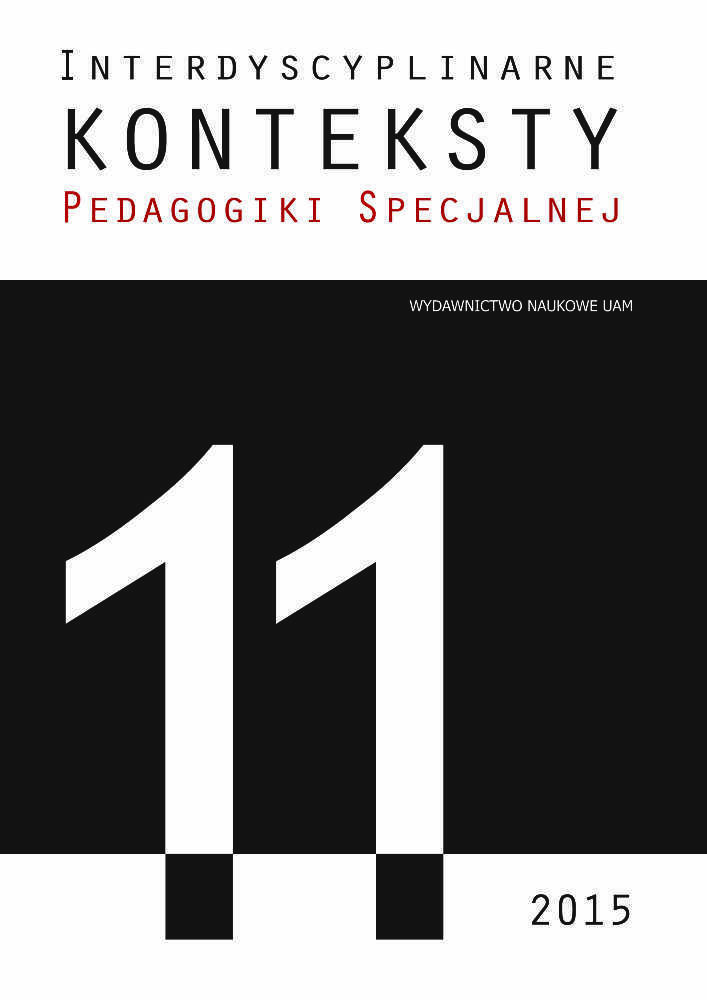Abstrakt
Last time a huge progress of researches regarding communication possibilities of children with Asperger’s syndrome can be noticed. Despite of this, the knowledge concerning this subject seems to be insufficient. There is also indisputable fact, that communication both on linguistic and non – linguistic level is incorrect. Disorders in this area might have different nature. Some children can be on a satisfactory level in linguistic area, some did not carve communication skills in sufficient level and it is hard to predict their development in this area. Additional difficult are huge differences between development of their communication skills. Communication ability is not only a part of socialization but also impacts on emotional and cognitive development, mainly because of it allows to extend area of experiences and understandding of world and people. Abnormalities which can be seen in development of children with Asperger’s syndrome dispose to think what kind of methods can be used in order to make efficient their functioning in social area.
Bibliografia
Adams C., Green J., Gilchrist A., Cox A., Conversational behavior of children with Asperger syndrome and conduct disorder, „Journal of Child Psychology and Psychiatry” 2002, 43.
Attwood T., Zespół Aspergera, Wydawnictwo Zysk i S-ka, Poznań 1998.
Bonnet K.A., Gao X.K., Asperger syndrome in neurologic perspective, „Journal of child neurology”, 1996, 11(6).
Bishop D.V.M., Chan J., Adams C., Hartley J., Weir F., Conversational responsiveness in specific language impairment: Evidence of disproportionate pragmatic difficulties in a subset of children, „Journal of Development and Psychopathology” 2000, 12.
Bishop D.V.M., Norbury C.F., Exploring the borderlands of autistic disorder and specific language impairment: a study using standardized diagnostic instruments, „Journal of Child Psychology and Psychiatry” 2002, 43.
Cytowska B., Wilczura B., Wczesna interwencja i wspomaganie rozwoju małego dziecka, Oficyna Wydawnicza „Impuls”, Kraków 2006.
Dobbinson S., Perkins M.R. Baucher J., Structural patterns in conversations with a woman who has autism, „Journal of Communication Disorders” 1998, 31.
Eisenymajer R., Prior M, Leekman S., Wing L, Gould J, Welham M, Ong B., Comparison of clinical symptoms in autism and Asperger’s Syndrome, „Journal of the American Academy of Child and Adolescent Psychiatry” 1996, 35.
Fine J., Bartolucci G., Ginsberg G., Szatmari P., The use of intonation to communicate in Pervasive Developmental Disorders, „Journal of Child Psychology and Psychiatry” 1991, 32.
Frith U., Autyzm i zespół Aspergera, Wydawnictwo Lekarskie PZWL, Warszawa 2005.
Frith U., Autyzm. Wyjaśnienie tajemnicy, GWP, Gdańsk 2008.
Garfin D.I., Lord C., Communication as a social problem in autism [w:] Social Behavior in Autism, Plenum Press, red. E. Schopler, Mesibov G., New York and London 1986.
Gillberg C., Gillberg I.C, Asperger syndrome – some epidemiological considerations: a research note, „Journal of Child Psychology and Psychiatry” 1989, 30.
Happe F., Autism: An Introduction to Psychological Theory, University College London, London 1994.
Jaklewicz H., Zaburzenia mowy w autyzmie wczesnodziecięcym, „Postępy Psychiatrii i Neurologii” 1994, 3.
Jolliffe T., Lansdown R., Robinson C., Autism: A personal account, „Communication Journal of the National Autistic Society” 1992, 26.
Kielar-Turska M., Badania nad dziecięcymi teoriami umysłu i ich znaczenie dla klinicznej psychologii dziecka, [w:] Wspomaganie rozwoju, psychostymulacja i psychokorekcja, red. B. Kaja, Wydawnictwo Akademii Bydgoskiej, Bydgoszcz 2002.
Koning C., Magill-Evans J., Social and language skills in adolescent boys with Asperger syndrome, „Autism” 2001, 5.
Kozdroń A., Zespół Aspergera. Zrozumieć aby pomóc, Wydawnictwo Difin, Warszawa 2015.
Krawczyk P.S., Desk reference to the Diagnostic Criteria from DSM – 5, Wydawnictwo Edra Urban & Partner Sp.z o.o., Wrocław 2015.
Kurcz I., Psychologia języka i komunikacji, Wydawnictwo Naukowe Scholar, Warszawa 2000.
Landa R., Piven J., Wzorek M.M, Gayle J.O, Chase G.A., Folstein S.E. Social language use in parents of autistic individuals, „Psychological Medicine” 1992, 22.
Marcinkowska B., Model kompetencji komunikacyjnych osób z głębszą niepełnosprawnością intelektualną – w poszukiwaniu wzajemności i współpracy, Wydawnictwo APS, Warszawa 2013.
Markiewicz K., Możliwości komunikacyjne dzieci autystycznych, Wydawnictwo UMCS, Lublin 2004.
Martin I., McDonald S., An exploration of causes of non–literal language problems in individuals with Asperger syndrome, „Journal of Autism and Developmental Disorders” 2004, 34.
Mohr J.P., Broca’s area and Broca’s aphasia, [w:] Studies in neurolingustics, red. H. Whitaker, Academic, New York 1976.
Pisula E., Autyzm u dzieci. Diagnostyka, klasyfikacja, etiologia, PWN, Warszawa 2001.
Pisula E., Od badan mózgu do praktyki psychologicznej. Autyzm, Wydawnictwo GWP, Sopot 2015.
Rzeźnicka-Krupa J., Inny i pedagogika: doświadczenie inności i relacja z innym jako istotne kategorie nauk o wychowaniu, „Studia Edukacyjne” nr 28/2013.
Stech K., Kompetencje zawodowe nauczyciela – spojrzenie na problem, [w:] Kompetencje nauczyciela – wychowawcy, red. K. Ferenz, E. Kozioł, Redakcja Wydawnictw Humanistyczno-Społecznych UZ, Zielona Góra 2002.
Tager-Flusberg H., On the nature of linguistic functioning in early infantile autism, „Journal of autism and developmental disorders” 1981, 11.
Tomasello M., The cultural origins of human cognition, Harvard University Press, Cambridge 1999.
Volden J., Loud C., Neologism and idiosyncratic language in autistic speakers, „Journal of Autism and Developmental Disorders” 1991, 21.
Williams D., Nikt nigdzie, Wydawnictwo Fraszka Edukacyjna we współpracy z Fundacją Synapsis, Warszawa 2005.
